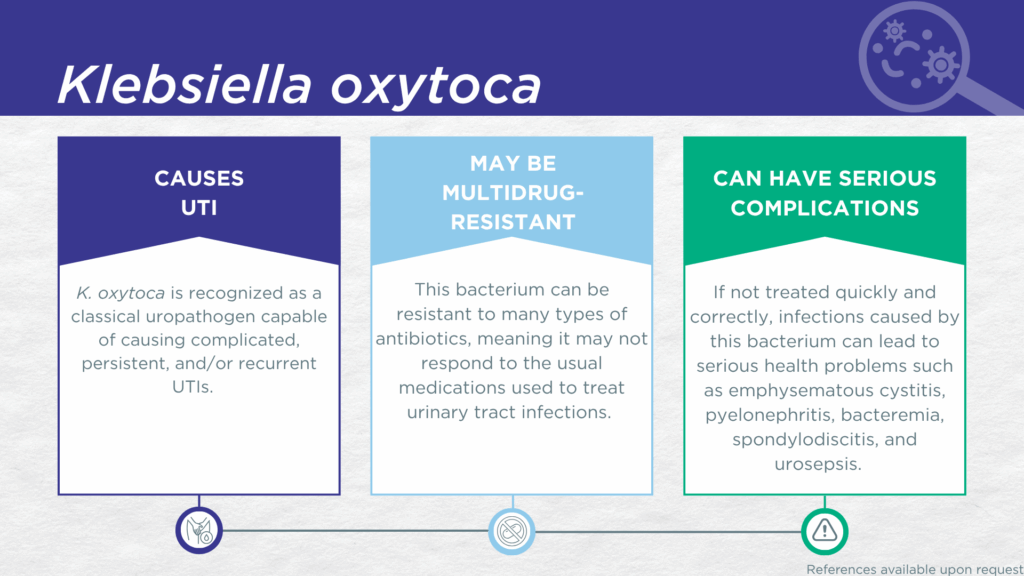K. oxytoca

Emery Haley, PhD, Scientific Writing Specialist
Klebsiella oxytoca
Clinical Summary
- K. oxytoca is recognized as a classical, urease-positive, gram-negative, biofilm-forming, uropathogen.
- K. oxytoca is primarily associated with recurrent UTIs and complicated UTIs in individuals with risk factors such as such as pregnancy, immunocompromise, multimorbidity, or urinary tract abnormalities.
- In symptomatic UTI patients, K. oxytoca:
- Is not a contaminant (is found in catheter-collected urine specimens).
- Is viable (can grow out on culture).
- Is pathogenic (associated with elevated urine biomarkers of infection).
- Reported severe complications of K. oxytoca UTI include emphysematous cystitis, pyelonephritis, bacteremia, spondylodiscitis, urosepsis, and death.
- Multidrug-resistant K. oxytoca is a significant and global health threat.
Bacterial Characteristics
Gram-stain
Gram-negative
Morphology
Bacillus
Growth Requirements
Non-fastidious (grows well in standard urine culture conditions)
Facultative anaerobe
Nitrate Reduction
Yes
Urease
Positive
Biofilm Formation
Yes
Pathogenicity
Colonizer or Pathobiont
Clinical Relevance in UTI
K. oxytoca is a urease-positive,[1] gram-negative, biofilm-forming, microorganism classically recognized as a uropathogen.
In preclinical studies of UTI, K. oxytoca exhibited the ability to adhere to epithelial cells of the bladder, and this ability was enhanced in the presence of E. coli, E. cloacae, Staphylococcus species, and other Klebsiella species.[2] Persistent and/or recurrent K. oxytoca UTIs are typically attributed to the epithelial adherence and biofilm formation abilities of K. oxytoca coupled with innate and acquired resistance to several antibiotics.[3–5] K. oxytoca is also a frequent cause of complicated UTI in both children and adults with risk factors such as pregnancy, immunocompromise, multimorbidity, or urinary tract abnormalities.[4]
In a study of older adult males and females with clinically suspected complicated UTI, K. oxytoca was detected in both midstream voided and in-and-out-catheter collected specimens indicating that it was truly present in the bladder, not simply a contaminant picked up during voiding.[6] Furthermore, elevated markers of immune system activation in the urinary tract have been measured from the same clinical urine specimens in which K. oxytoca was detected, indicating that the presence of K. oxytoca was associated with an immune response to urinary tract infection.[7–9]
The World Health Organization (WHO) has included third-generation-cephalosporin-resistant and carbapenem-resistant Enterobacterales, including K. oxytoca, in the “critical” group of the 2024 Bacterial Priority Pathogens List (BPPL).[10] Severe reported complications of K. pneumoniae UTI include emphysematous cystitis, pyelonephritis, bacteremia, spondylodiscitis, urosepsis, and death.[11–13]
Together, these findings indicate that K. oxytoca should be seriously considered as a uropathogen and demonstrate the value of detecting this organism in both children and adults experiencing recurrent UTI or with risk factors for complicated UTI, such as pregnancy, immunocompromise, multimorbidity, or urinary tract abnormalities.
Treatment
Evidence of Efficacy (Checkmarks): Amoxicillin/Clavulanate, Ampicillin/Sulbactam, Cefaclor, Cefazolin, Cefepime, Ceftazidime, Ceftriaxone, Cephalexin, Ciprofloxacin, Doxycycline, Gentamicin, Levofloxacin, Meropenem, Nitrofurantoin, Piperacillin/Tazobactam, Sulfamethoxazole/Trimethoprim, and Trimethoprim.
- BacDive | The Bacterial Diversity Metadatabase Available online: https://bacdive.dsmz.de/ (accessed on 11 February 2025).
- Giliazeva, A.; Akosah, Y.; Noack, J.; Mardanova, A. Adhesion of Klebsiella Oxytoca to Bladder or Lung Epithelial Cells Is Promoted by the Presence of Other Opportunistic Pathogens. Microb. Pathog. 2024, 190, 106642, doi:10.1016/j.micpath.2024.106642.
- Ahn, S.T.; Lee, H.S.; Han, D.E.; Lee, D.H.; Kim, J.W.; Park, M.G.; Park, H.S.; Moon, D.G.; Oh, M.M. What Are the Risk Factors for Recurrent UTI with Repeated ESBL-Producing Enterobacteriaceae? A Retrospective Cohort Study. J. Infect. Chemother. 2023, 29, 72–77, doi:10.1016/j.jiac.2022.09.020.
- Yang, J.; Long, H.; Hu, Y.; Feng, Y.; McNally, A.; Zong, Z. Klebsiella Oxytoca Complex: Update on Taxonomy, Antimicrobial Resistance, and Virulence. Clin. Microbiol. Rev. 2021, 35, e00006-21, doi:10.1128/cmr.00006-21.
- Shrief, R.; Hassan, R.H.; Zaki, M.E.S.; Rizk, M.A. Molecular Study of Klebsiella Oxytoca Associated with Urinary Tract Infection in Children. Open Microbiol. J. 2022, 16, doi:10.2174/18742858-v16-e2201070.
- Wang, D.; Haley, E.; Luke, N.; Mathur, M.; Festa, R.; Zhao, X.; Anderson, L.A.; Allison, J.L.; Stebbins, K.L.; Diaz, M.J.; et al. Emerging and Fastidious Uropathogens Were Detected by M-PCR with Similar Prevalence and Cell Density in Catheter and Midstream Voided Urine Indicating the Importance of These Microbes in Causing UTIs. Infect. Drug Resist. 2023, Volume 16, 7775–7795, doi:10.2147/idr.s429990.
- Haley, E.; Luke, N.; Mathur, M.; Festa, R.A.; Wang, J.; Jiang, Y.; Anderson, L.A.; Baunoch, D. The Prevalence and Association of Different Uropathogens Detected by M-PCR with Infection-Associated Urine Biomarkers in Urinary Tract Infections. Res. Rep. Urol. 2024, 16, 19–29, doi:10.2147/rru.s443361.
- Akhlaghpour, M.; Haley, E.; Parnell, L.; Luke, N.; Mathur, M.; Festa, R.A.; Percaccio, M.; Magallon, J.; Remedios-Chan, M.; Rosas, A.; et al. Urine Biomarkers Individually and as a Consensus Model Show High Sensitivity and Specificity for Detecting UTIs. BMC Infect Dis 2024, 24, 153, doi:10.1186/s12879-024-09044-2.
- Parnell, L.K.D.; Luke, N.; Mathur, M.; Festa, R.A.; Haley, E.; Wang, J.; Jiang, Y.; Anderson, L.; Baunoch, D. Elevated UTI Biomarkers in Symptomatic Patients with Urine Microbial Densities of 10,000 CFU/ML Indicate a Lower Threshold for Diagnosing UTIs. MDPI 2023, 13, 1–15, doi:10.3390/diagnostics13162688.
- 2024 WHO Bacterial Priority Pathogens List (WHO BPPL) Available online: https://iris.who.int/bitstream/handle/10665/376776/9789240093461-eng.pdf?sequence=1 (accessed on 18 March 2025).
- Shahab, K.; Mufti, A.Z.; Iqbal, M.A.; Roghani, M.; Zeb, F.; Amin, U. Assessment of Microbial Diversity Pattern of Sensitivity and Antimicrobial Susceptibility in Patients Admitted with Urosepsis. Ann. PIMS-Shaheed Zulfiqar Ali Bhutto Méd. Univ. 2023, 19, 339–345, doi:10.48036/apims.v19i3.924.
- Brooks, C.A.; Mahajan, S.; Beresford, R.; Damodaran, O.; Pope, R. Thoracic Spondylodiscitis Secondary to Klebsiella Oxytoca Urosepsis —a Case Report. J. Spine Surg. 2022, 0, 0–0, doi:10.21037/jss-21-124.
- Ahmed, N.; Sabir, S.; Khan, N. Emphysematous Cystitis Due to Klebsiella Pneumoniae. Ann. Saudi Med. 2008, 28, 50–52, doi:10.5144/0256-4947.2008.50.
Dr. Emery Haley is a scientific writing specialist with over ten years of experience in translational cell and molecular biology. As both a former laboratory scientist and an experienced science communicator, Dr. Haley is passionate about making complex research clear, approachable, and relevant. Their work has been published in over 10 papers and focuses on bridging the gap between the lab and real-world patient care to help drive better health outcomes.